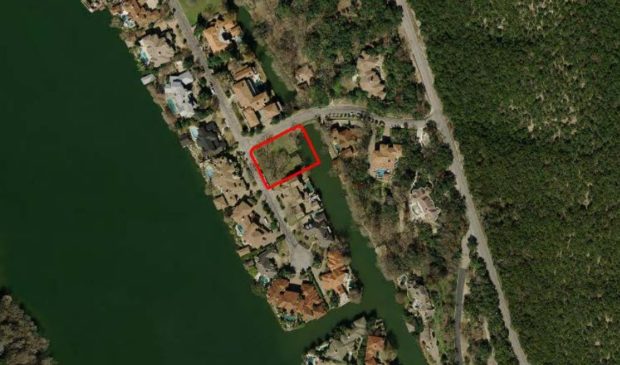At the Environmental Commission, man-made islands get man-made variances
Tuesday, September 25, 2018 by
Jessi Devenyns There are few undeveloped lots along Lake Austin. However, those that are find themselves uniquely positioned as a clean slate that is ideal for a new, modern home – except when the lot is the wrong shape.
Just underneath Mt. Bonnell on a man-made island is one of these empty plots. The 0.55-acre lot at 4409 Island Cove was originally intended to be two lots, and as such the current single lot was bestowed with two separate boat slips at two separate locations of the property.
However, the property owners designed a plan that featured a house and a single dock at the far end of the property, which the city approved and granted the building permits for before a variance that allowed for the reconfiguration of the existing docks was given. The permits cannot be pulled until the variance is given.
Therefore, David Cancialosi of Permit Partners, who was representing the applicant, came before the Environmental Commission on Sept. 19 to ask that the commission allow them to fill in the two existing boat slips and cut in another single slip wide enough for two boats.
“It’s a little bit cart before the horse,” noted Atha Phillips, the environmental program coordinator at the Watershed Protection Department, who was presenting the project. She explained that because the homeowners could have used the existing slips, the variance is not required to allow for “reasonable use of the property,” and so staff did not support the request.
Despite the unusual sequence of events, the Environmental Commission recommended the variance for approval.
The commissioners questioned how the process had moved forward in such an unusual fashion. “It is a bit troubling to me the way this process played out because it puts us in a bit of an awkward position,” said Commissioner Marisa Perales. She questioned why the applicant had not generated a secondary design that could have been used should they not receive permission to fill in the existing slips in favor of constructing a new one.
Cancialosi explained that it came down to timing. Homes, he said, are more difficult to get permitted, and so the team worked “to see if we were going to hit a snag on that part.” The reconstruction of the slips, he noted, is a one-to-one trade and so he did not expect many difficulties.
Staff did not dispute his claim. Phillips told the commission, “They’re actually filling in as much as they’re cutting,” and Acting Environmental Officer Chris Herrington said that the change was “net zero.”
Furthermore, the project is calling for a healthy amount of mitigation. Since the plans call for the removal of some trees in order to allow for construction, staff explained that, although the applicant is only required to offer 20 inches of tree mitigation, they are planting 32 inches. In addition, the plans show that the homeowners will be planting a host of native plants along the banks to help improve the flood plain to a “good” designation, which according to staff is currently “in very poor condition.” The proposed impervious cover for the project is also under the maximum limit.
With all of these environmental benefits in mind, as well as the fact that the house was “designed in a manner that fits the neighborhood,” the commission voted unanimously to recommend this variance for approval.
Photo courtesy of the city of Austin.
The Austin Monitor’s work is made possible by donations from the community. Though our reporting covers donors from time to time, we are careful to keep business and editorial efforts separate while maintaining transparency. A complete list of donors is available here, and our code of ethics is explained here.
You're a community leader
And we’re honored you look to us for serious, in-depth news. You know a strong community needs local and dedicated watchdog reporting. We’re here for you and that won’t change. Now will you take the powerful next step and support our nonprofit news organization?









